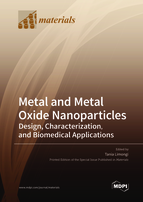Metal and Metal Oxide Nanoparticles: Design, Characterization, and Biomedical Applications
A special issue of Materials (ISSN 1996-1944). This special issue belongs to the section "Advanced Nanomaterials and Nanotechnology".
Deadline for manuscript submissions: closed (31 December 2020) | Viewed by 23406
Special Issue Editor
Interests: nanoparticles; extracellular vesicles; drug delivery; nanomedicine; in vitro study; nanotoxicology
Special Issues, Collections and Topics in MDPI journals
Special Issue Information
Dear Colleagues,
Developing new materials is usually a time-demanding and meticulous process, but at the same time, it is one of the more promising solutions to obtain a cleaner, safer, and smart future. More in detail, referring to nanomaterials, an increasingly successfully tool of nanotechnologies, nanoparticles are categorized as materials in which at least one dimension is less than 100 nm in diameter. Among the various nanoparticles’ categories, metal and metal oxides nanoparticles stand as an emerging nanotechnological solution for a wide range of biological and medical physio/pathological open questions. This Special Issue covers the fundamental science, design, characterization, and biomedical applications of metal and metal oxide nanomaterials. The articles here presented will embrace all the aspects determining the performance of these systems, ranging from their synthesis, design, chemical, physical, and biological functionalization, to their characterization and successful applications. Therefore, this Special Issue welcomes contributions from all scientists producing and/or applying metal and metal oxides nanoparticles in a diagnostic, therapeutic or theranostics contest.
The Special Issue will cover but not be limited to the following topics:
- Methods and strategies for metal and metal oxide nanoparticles’ synthesis;
- Engineering metallic nanoparticles;
- Metallic nanoparticles’ diagnostic applications;
- Metallic nanoparticles’ therapeutic applications;
- Metallic nanoparticles’ theranostics applications.
Dr. Tania Limongi
Guest Editor
Manuscript Submission Information
Manuscripts should be submitted online at www.mdpi.com by registering and logging in to this website. Once you are registered, click here to go to the submission form. Manuscripts can be submitted until the deadline. All submissions that pass pre-check are peer-reviewed. Accepted papers will be published continuously in the journal (as soon as accepted) and will be listed together on the special issue website. Research articles, review articles as well as short communications are invited. For planned papers, a title and short abstract (about 100 words) can be sent to the Editorial Office for announcement on this website.
Submitted manuscripts should not have been published previously, nor be under consideration for publication elsewhere (except conference proceedings papers). All manuscripts are thoroughly refereed through a single-blind peer-review process. A guide for authors and other relevant information for submission of manuscripts is available on the Instructions for Authors page. Materials is an international peer-reviewed open access semimonthly journal published by MDPI.
Please visit the Instructions for Authors page before submitting a manuscript. The Article Processing Charge (APC) for publication in this open access journal is 2600 CHF (Swiss Francs). Submitted papers should be well formatted and use good English. Authors may use MDPI's English editing service prior to publication or during author revisions.
Keywords
- Metal nanoparticles
- Metal oxides nanoparticles
- Synthesis
- Nanoparticles’ functionalization
- Nanoparticles’ engineering
- In vitro and in vivo study
- Diagnosis
- Therapy
- Theranostics







